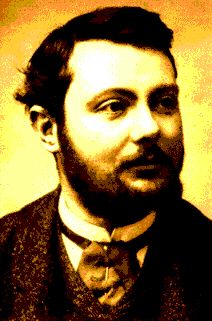Paul Louis Toussaint Héroult (1863 - 1914)
Paul Louis Toussaint Héroult was born in 1863 into a world of country folk and cottage industries. His father, Patrice, managed a small tannery on the banks of the Orne River, at Saint-Bénin, a peaceful location where the Héroult family had lived for generations. Paul might have been expected to continue the business his grandfather had started, but rather than an honorable tanner, he became an inventor.

The major influence, however, was the fortuitous meeting with an old friend of his father's, Mr. Belliot, a lawyer by profession, highly cultured, with a magnificent personal library. After school, Paul spent hours discovering the joys of reading. Science, and particularly, research and discovery, began to fascinate the Paul. His interest reaches its highest point the day he comes upon the famous work of Sainte-Claire Deville, with the unglamorous title, "Aluminum, its properties, its production and applications".
He entered the prestigious École des Mines after a brilliant entrance examination in 1882, at the age of 19. A friendship developed between him and his chemistry professor, who was also fascinated by aluminum.
While a student at the École des Mines, Paris, Héroult began working on the electrolysis of aluminum compounds. Paul did sketch after sketch, tried one assumption after another, at the expense of the other subjects he should have been studying. As a result, he failed his first year and was dismissed from school. Paul Héroult is thus back on his own; his father dies unexpectedly during 1883, leaving him the tannery buildings, which he decides to use for his experiments. He induces a few fellow students from l'Ecole des Mines to join him, such as Louis Merle and Lucien Van Kerguistel, and they begin to work on electrolysis.
His mother gave him her last 50,000 francs to acquire the Bréguet dynamo (400 amperes, 30 volts) which he needed. But the attempts were indecisive. Aluminum was produced sporadically until Héroult lowered the temperature of the bath and added a trace of metallic oxide. The oxide was reduced, fell to the bottom of the crucible and triggered the joining of the new metal into a mass. In 1886 he discovered that electrolysis of a solution of alumina (aluminum oxide) in molten cryolite (sodium aluminum fluoride) resulted in the formation of a layer of molten aluminum at the bottom of the vessel. Electrolytic aluminum was born. Without missing a beat, Héroult applied for a patent. This was the 23rd of April 1886 and Paul was 23 years old. The Héroult process is essentially identical to the one discovered by Hall in the same year. After prolonged patent litigation, an agreement was reached between the two inventors.
But with growing charisma, Héroult was able to persuade the Société Electrometallurgique Française to build a new, larger capacity plant, at La Praz in the Maurienne valley. He did not at first participate in its installation, because at the very same time a brand new company, the Société Française de l'Aluminium Pur was experimenting with the new Bayer process. Naturally Héroult was asked to study and evaluate it. His findings led the management of the SEMF to absorb the new company in 1895. This was the beginning of a period of collaboration between Héroult and Bayer, both tirelessly searching for a lower cost in the production of aluminum. Together they went to the United States to study at close range the Hall process, as used in the South Wilmington alumina plant. The process did not appear to give better results than their own.
In 1912 he forged ahead again within a new organization l'Aluminium Français, one of whose objectives was to build an aluminum plant in the United States. The everlasting pioneer embarked on this new adventure, and found himself lost in a wild, mosquito and snake ridden jungle, at the foot of the Yadkin River falls in North Carolina, along with his wife and his son, Paul, who helped on horseback with the surveying. But our inventor's health was affected and he had to continue his work bedridden, in the tropical heat, within the old colonial house that had been lent him. Those about him urged him to return to France, and get some much deserved rest, but he would not listen. On the contrary, he seemed to offset his physical handicap by increased determination, until two unfortunate events occurred, the illness of his son, stricken with malaria, which forced him to go home, and the threat of war, which postponed the building of the plant.

Connect with us
Contact us today